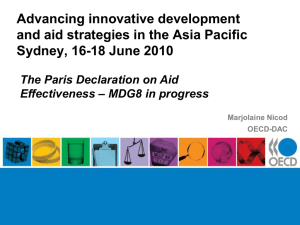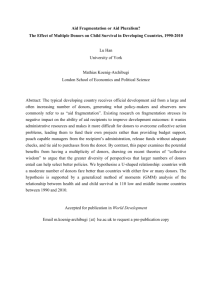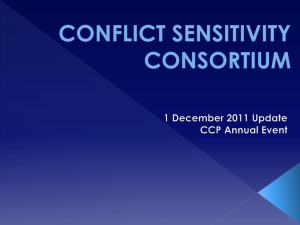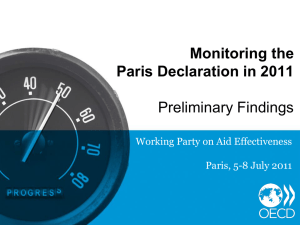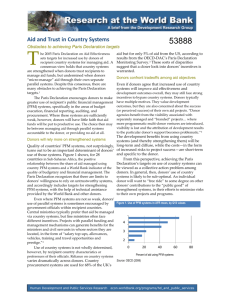aid effectiveness in light of the paris declaration and the accra
advertisement
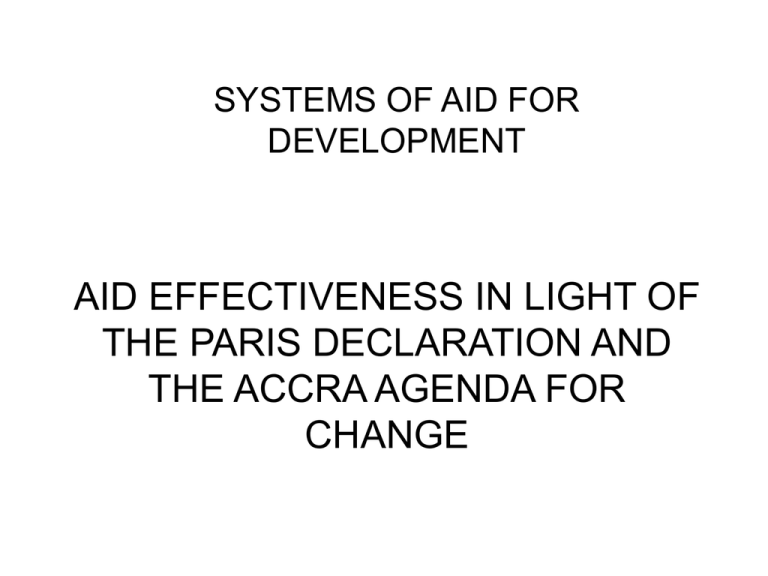
SYSTEMS OF AID FOR DEVELOPMENT AID EFFECTIVENESS IN LIGHT OF THE PARIS DECLARATION AND THE ACCRA AGENDA FOR CHANGE What is Development Human development - a process of ‘enlarging people’s choices’ emphasizing the freedom to be healthy, to be educated and to enjoy a decent standard of living Aid - an intervention • Intervention – The action of governments and donors by providing aid out of the belief that it will achieve a desired effect and impact Systems of Aid for Development • Strong Interventionist – top-down aid: When governments and donors are sure that they know what is the precise intervention needed for Development they tend to set precise terms and conditions for the beneficiaries. For example: Structural Adjustment Policies up to the late 1990’s Systems of Aid for Development • Interventionist – aid via dialogue and partnership: Governments and donors provide aid that is more closely formulated and implemented in coherence with national development plans, national priorities, and national planning and implementation. Partner countries are required for strong leadership of development interventions and donor coordination. Mainly represented in The Paris declaration, The Accra Agenda for Action The Accra Agenda for Action • • • • Greater use of country systems and program-based approaches. Provision of capacity development that is ‘demand driven’. Increased aid predictability and transparency of aid flows. Better division of labour and donor harmonization to reduce fragmentation of aid. Uganda 2009/10: project aid represented 40% of budgeted expenditures in the priority sectors of health, education, roads, agriculture and water representing over two thirds of development expenditure in those sectors. (Uganda Ministry of Finance Planning and Economic Development, 2010) The Paris Declaration • Local “ownership” should be strengthened by ensuring that the government of a country receiving aid sets the agenda. • Aid donors should align their thinking and programmes with the host government’s policies and management systems. • Improved harmonisation of different aid donors’ development programmes through closer cooperation and agreed divisions of labour. • Managing for Results - better evaluation of development results • Mutual accountability so that both aid recipients and donors are equally accountable. Systems of Aid for Development • Interventionist – bottom-up aid: Governments and donors recognize their inability to understand accurately the recipient's needs, therefore, providing aid on the bases of local needs and problem solving/crises alleviation. Examples: microfinance banking to help the poor; aid for disaster relief Systems of Aid for Development • Weak interventionist – 'counterfactual aid evaluation': Governments and donors focus on the degree to which aid improves the well-being of the poor. These evaluations set out to answer what they call the counterfactual question of whether beneficiaries’ well-being would have changed even if the intervention had not taken place. Counterfactual aid proposes aid to be randomised and experimental. European Commission – ‘Evalsed’ the resource for the evaluation of socio-economic development Systems of Aid for Development • Weak interventionist – aid for self development: Aid for Development can be verified, developing countries do not need a higher GDP, but find their unique way to develop. The path for development differs from one country to the other by its merits and weakness. Emphasis should be given to local and traditional knowledge, and South-South knowledge exchange. Development will result from strengthening these abilities. “the correlation between GDP per capita growth and nonincome [Millennium Development Goals] is practically zero” François Bourguignon, director of the Paris School of Economics; HDI 2010 pp. 47 The Real Wealth of Nations: Pathways to Human Development, HDRO-UNDP – November 2010 Lack of sustainability is arguably the greatest challenge to human development • CO2 emissions have risen 163 percent between 1970 and the mid-2006. Arguably the greatest challenge to human development lies in unsustainable production and consumption patterns and above all, the threat of climate change. Worsening of key measures of sustainability, 1970-2006/8 The Real Wealth of Nations: Pathways to Human Development, HDRO-UNDP – November 2010
